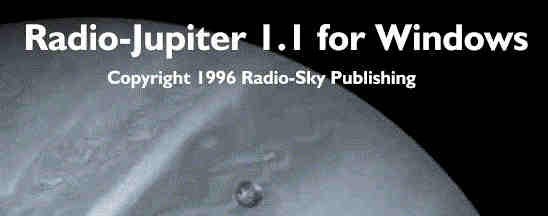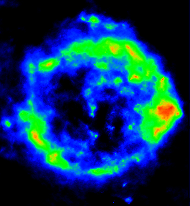Radio Astronomy Software
Available from Radio-Sky Publishing.
NOTE: Every Piece of Software on this page (and
more!) is included in the Radio-Sky CDROM I

Radio-Jupiter 1.0 for Windows
You can greatly increase the likelihood of successfully monitoring Jupiter's
decametric noise storms by listening in at the times of greatest probability.
Radio-Jupiter is a prediction tool which calculates those times
based upon known correlations in Jupiters rotation, Io's orbit, and your
position on the Earth. In the windows environment you can leave Radio-Jupiter
running in the background and receive audible alerts when a storm is in
progress. You get altitude and azimuth tracking information for your antenna.
A quick look graphical display lets you see a day's Jupiter activity at
a glance. This new Windows version has some very nice features like playing
examples of storms through your sound card and monthly reports generation.
Windows 3.1 or Win95. $30
Click here to see the type of info you get with Radio-Jupiter
for Windows.
Radio-Jupiter 2.0 for DOS
No windows??? The DOS version is still available. Comprehensive on line
help screens and mouse support make using this program a snap. The DOS
version actually does a couple of things that the Windows version presently
does not do. You can graph the Jovicentric declination of the Earth over
a period of years. You can also run a schematicized simulation of the emission
modes and see how they play together over time. No sound, alert, or monthly
reports are available though. M.S. DOS 3.5" format. $25
Data Collect Lite 1.0
We call this version "Lite", because it is easy on the pocket book from
a hardware and software perspective. Uses your computer and an inexpensive
8, 12, or 16 bit analog to digital converter to produce strip charts and
disk storage of radiotelescope observations. Expand or crop vertical and
horizontal chart scale. Dump the chart to a printer or a PCX file for inclusion
into articles. You can build an 8 or 12 bit converter yourself for about
15 - $25, (we provide you with the schematics), or order a kit. The converter
uses your printer port. We also supply a driver for the Radio-Shack computer
interfaceable DVM. If you are a hardware designer, you can even write your
own printer port interface for your device using a simple to use driver
editor which we provide (16 bit resolution limit!). You get automated observing
when you use DCL 1.0 with Radio-Sky Planetarium 1.2. Data Collect Lite
1.0 can read the schedule files produced by the RSP 1.2 program, and begin
and end data collection at the appropriate times. There is full mouse support,
easy to use on screen documentation, Epson 9 and 24 pin and HP Laser Jet
printer support. VGA, EGA, and CGA monitors supported. MS DOS . $25.00
Data Collect Lite for Windows
Similar to DCL1 for DOS except it does not presently support serial port
(comm port) analog to digital converters such as the Radio Shack computer
interfaced DVM. $30
Click here to see schematics for simple analog
to digital converters which you can build and use with Data Collect
Lite Software.
Radio-Sky Planetarium 1.2

Cass A seen by radio.
Here is a sky viewer with the amateur radio astronomer in mind. RSP
1.2 is not just a sky viewer with a radio source database. It was originally
written as an observation scheduling tool. From there it evolved into useful
educational device. We are not trying to fool you. This is a program written
for the DOS operating system. As such, it is not as graphically advanced
as a lot of modern Windows programs.... but just look at what it can do:
The sky can be displayed in galactic or equatorial coordinates. There
is even a polar view available for the sky within 30 degrees of the celestial
poles. Pulsars, supernova remnants, extragalactic sources such as active
galaxies and quasars, the Sun, and Jupiter, are all available to you. What's
more, the database is completely open ended. We even provide you with the
tools to make your own database for RSP 1.2. Information screens (like
the one above) and spectral tabulations are available for sources at the
press of a mouse button. You can establish an observing schedule with source
transit information with just two button presses! A schedule file is produced
which can be used to automate your radio telescope observations. Throw
your radio telescope beam pattern on the screen and maintain a real time
display of what sources are in your antenna pattern. Other features include:
-
Horizon, Meridian and Date Lines.
-
Galactic Equator.
-
Celestial Equator.
-
Zoom with fully adjustable aspect ratio.
-
Accurate from 1899 to 2099 AD.
-
Map based latitude and longitude changes.
-
ALTAZ / RADEC display.
-
Find Feature.
-
Adjustable beam pattern.
-
Minimum flux filter.
-
Adjustable symbol size.
-
Saves any display to PCX file.
-
50 help screens.
-
Extensive on disk documentation.
-
Stars down to mag 4.6 available as guideposts.
-
Mouse friendly clock and calender controls.
-
Real time displays of local, GMT, and local sidereal times.
-
Tools for default editing, database creation, and precession of databases.
-
Additional databases available.
Note that because Windows is not required, this is a great program to leave
running on that dusty old AT computer to keep a constant picture of what
is in your antenna beam during drift scans.
Requirements: MS DOS, 512k ram, CGA, EGA, or VGA monitor., hard drive.
Recommend: mouse, VGA. Price: $25
Additional Databases for Radio-Sky Planetarium 1.2
The following compilations of radio sources have been produced for your
convenience. The survey data is not copyrighted by us. It is free to all.
Numerous other surveys are available in raw text form via internet. Information
and software tools are provided with RSP12 which allow you to produce your
own compilations. If you don't want to download and convert then you may
want to order these preformatted surveys from us. The cost is only $10
each. .
The RSP Formatted Multiple Survey Catalog 1.0 This is a compilation
of 6734 radio source records of flux greater than or equal to 10 Janskys.
The information was extracted from from a "master source list". The nature
of this catalog differs from others published by Radio-Sky in that no effort
was was made to combine multiple observations of a single source into one
record. Thus, fewer than six thousand different sources are actually represented.
The multiple observations still have importance in that most were done
at different frequencies. Click here to see a screen
showing a plot of all of these sources.
Parkes Survey in RSP Format - This diskette contains a catalog
of 5051 sources extracted from the PKSCAT90 catalog. The sources herein
are those which exhibit a flux density of at least 1 Jansky at one of the
observed frequencies. The original survey and catalog are the results of
work done by the Australian Telescope National Facility. Sources in the
galactic plane and within the Large Magellanic Cloud are largely excluded,
as these sources were the subjects of other detailed surveys. Telescopes
used for the survey included the Parkes radio telescope and telescopes
at the Molonglo and Culgoora observatories.
The RSP Formatted Green Bank 4.85 Ghz Sky Survey This is a compilation
of 10,549 sources of flux greater than or equal to 100 millijanskys (.1
Janskys), at 4.85 GHz, extracted from the 87GB catalog of radio sources.
The survey covers 0 to 75 degrees in declination. Sources of more than
20 arcminutes in extent are suppressed. Some strong sources are thus not
represented. The survey was taken using the now defunct 300 ft. telescope
at the National Radio Astronomical Observatory in Green Bank, West Virginia.
Green Bank 1.4 Ghz Survey in RSP Format The original survey had
over 32000 sources. This has been trimmed to 2641 by elimination of all
sources less than 750 milliJanskys at the survey frequency. Some of the
sources have additional flux information taken from surveys at 4.85 GHz and/or 365
MHz. Where this information is available it should supercede
in reliability the calculated flux densities provided by the RSP program
as these are based on the rather liberal assumption of a spectral index
of .8. As provided this survey is based on 1950 RA coordinates.
HOME
| BEGINNERS | JUPITER
| SOLAR | PULSARS
| PROJECTS | FAQ
| BOOKS | SOFTWARE
| SUPPORT | ORDERING
| LINKS | CONTACT
| DISCUSSION


